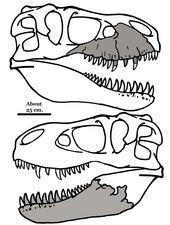Zhuchengtyrannus
| Zhuchengtyrannus | ||||||||||||
|---|---|---|---|---|---|---|---|---|---|---|---|---|

Live reconstruction of Zhuchengtyrannus |
||||||||||||
| Temporal occurrence | ||||||||||||
| Campanium ( Upper Cretaceous ) | ||||||||||||
| 83.6 to 72 million years | ||||||||||||
| Locations | ||||||||||||
| Systematics | ||||||||||||
|
||||||||||||
| Scientific name | ||||||||||||
| Zhuchengtyrannus | ||||||||||||
| Hone et al., 2011 | ||||||||||||
| Art | ||||||||||||
|
||||||||||||
Zhuchengtyrannus is a genus theropod dinosaur from the family of Tyrannosauridae that approximately 83.6 to 72 million years ago in the late Cretaceous period in what is now China lived. The type species and only species in the genus is Zhuchengtyrannus magnus .
etymology
Zhuchengtyrannus was scientifically described and named in 2011 by David WE Hone, Kebai Wang, Corwin Sullivan, Xijin Zhao, Shuqing Chen, Dunjin Li, Shuan Ji, Qiang Ji and Xing Xu. The genus name is derived from Zhucheng , the site of the fossil remains, and " tyrannus " refers to its phylogenetic position as a tyrannosaurid. The species name " magnus ", which means "large" in Latin, refers to the relative size of Zhuchengtyrannus .
discovery
Zhuchengtyrannus is only known from the holotype specimen ( ZCDM V0031 ), an almost complete right upper jaw and a corresponding left lower jaw, both with teeth. Zhuchengtyrannus was found in an area that was a floodplain in the Cretaceous Period and has one of the highest concentrations of dinosaur bones in the world. It is dated to at least 73.5 million years ( Campanium ) before our time. A second tyrannosaurid dentine ( ZCDM V0030 ) and an upper jaw fragment ( ZCDM V0032 ) were also found at the site of discovery. Although not related, both specimens differ from other tyrannosaurids, including Zhuchengtyrannus , which implies the existence of at least one additional tyrannosaurid in the habitat. Apart from the tyrannosaurid material, remains of Sinoceratops , Hadrosauriden and Ankylosauriden were also discovered.
features
Zhuchengtyrannus was a great carnivorous theropod and probably the top predator of his time. It is believed that adult animals reached a length of up to 12 meters and a weight of up to 6 tons. The teeth are somewhat smaller than those of most specimens of the Tyrannosaurus rex and somewhat larger than those of Tarbosaurus bataar , but significantly smaller than the corresponding teeth of the largest Tyrannosaurus specimens such as " Sue ".
Systematics
In a phylogenetic analysis published with the description of Lythronax , Zhuchengtyrannus was a sister taxon of Tarbosaurus . This suggests that Zhuchengtyrannus and other currently known Asian tyrannosaurids were part of an evolutionary tribe that descended from the same North American tribe that later became Tyrannosaurus , which turned out to be its closest known relative. Below is a cladogram by Loewen et al. from 2013:
| Tyrannosauridae |
|
||||||||||||||||||||||||||||||||||||||||||||||||||||||
|
|
Web links
Individual evidence
- ↑ a b c David WE Hone, Kebai Wang, Corwin Sullivan, Xijin Zhao, Shuqing Chen, Dunjin Li, Shuan Ji, Qiang Ji and Xing Xu: A new, large tyrannosaurine theropod from the Upper Cretaceous of China. In: Cretaceous Research , Volume 32, Number 4, 2011, pp. 495-503, doi : 10.1016 / j.cretres.2011.03.005 , ( digitized version ).
- ↑ Mark A. Loewen, Randall B. Irmis, Joseph JW Sertich, Philip J. Currie & Scott D. Sampson: Tyrant Dinosaur Evolution Tracks the Rise and Fall of Late Cretaceous Oceans . In: PLoS ONE . tape 8 , no. 11 , November 6, 2013, ISSN 1932-6203 , doi : 10.1371 / journal.pone.0079420 , PMID 24223179 , PMC 3819173 (free full text).

